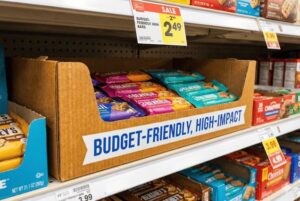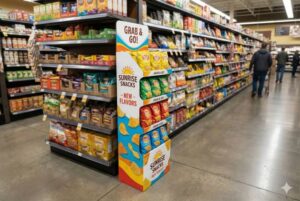Confusion about acronyms can slow down your retail strategy and frustrate your team. You likely see "PDQ" written on orders or hear it in meetings, but do you actually know how it impacts your product’s visibility?
PDQ stands for "Pretty Darn Quick" in general slang, but in retail, it refers to "Product Display Quickly" or pre-loaded display trays. These ready-to-sell units are designed for fast setup in stores like Walmart and Costco to drive impulse buys and speed up stocking.
As a cardboard display manufacturer in China, I help brands navigate these terms every day. Whether you are a large corporate buyer or a franchise owner, understanding the nuance of this term is vital. It affects everything from your shipping costs to how fast your product gets onto the shelf. Let’s clear up the confusion so you can choose the right packaging for your next big launch.
What does PDQ mean in slang?
You might hear this term in casual conversation before you ever hear it in a board meeting. Understanding the root of the phrase helps explain why the retail world adopted it.
In slang, PDQ simply means "Pretty Darn Quick." It is an informal phrase used to demand speed or immediate action. While it originated in casual speech, the concept of speed is exactly why the retail industry adopted the acronym for their fast-moving display solutions.
The evolution of language is fascinating, especially when business adopts casual terms. In the early days, "Pretty Darn Quick" was just a way to tell someone to hurry up without swearing. It implies urgency. In my factory, time is always a critical factor. When a client tells me they need a prototype, the spirit of PDQ is always present.
However, we need to look at how this cultural demand for speed translated into a physical product. We live in a fast-paced world. Consumers want products now, and retailers want shelves stocked instantly. The slang definition set the stage for the business application. If a task is not done PDQ, you lose money. This mindset is what drove the invention of display packaging that eliminates wasted time.
Here is a simple breakdown of how the meaning shifts depending on who you are talking to:
| Context | Meaning | Implication |
|---|---|---|
| Casual Conversation | Pretty Darn Quick | Hurry up, do not delay. |
| Military (Origin) | Immediately | An order that must be executed now. |
| Business Operations | High Efficiency | Reducing lead times and friction. |
| Manufacturing | Fast Turnaround | Rapid prototyping and production. |
In my experience dealing with US buyers, the slang meaning often overlaps with the business request. Clients often say, "I need this shipment PDQ." It is a mindset before it is a box.
What does PDQ mean in retail?
This is where your product meets the customer and where the acronym becomes a technical term. If you get this wrong, your merchandise might just sit in the warehouse instead of selling.
In retail, PDQ refers to "Product Display Quickly" or "Pretty Darn Quick" displays. These are point-of-purchase (POP) units that come pre-loaded with merchandise. They allow store employees to place products on shelves or counters instantly without unpacking individual items, saving labor costs and boosting sales.
In the retail sector, specifically in grocery and big-box stores, a PDQ is a game-changer. I often explain to my clients that a PDQ is not just a box; it is a sales acceleration tool. The goal is to stop the customer in their tracks and encourage an impulse buy. This is why Countertop Displays and Shelf Displays are so popular. They put the product right in the line of sight.
From a manufacturing perspective, we design these trays to be sturdy yet temporary. We use corrugated cardboard because it is cost-effective and printable. The market data supports this trend. The demand for Floor POP Displays and smaller counter units is growing fast because they work. Brands get better visibility, and retailers save money on labor because their staff does not have to stock individual items.
However, there are challenges. The design must be perfect. If the walls of the tray block the product, it will not sell. If the material is too weak, it looks cheap.
Here is why retailers prioritize PDQ displays over standard loose products:
Why Retailers Love PDQs
1) Speed to Shelf: A stock clerk can open one master carton and place the tray on the shelf in seconds.
2) Organized Presentation: The products stay neat and do not fall over, keeping the aisle looking good.
3) Brand Consistency: You control the branding on the tray, ensuring your logo is seen even if the product is small.
4) Impulse Power: Small PDQs near the register capture attention while customers wait to pay.
I once had a client who ignored the structural design of the front lip of the display. The products kept tipping over. We redesigned it with a slightly higher front edge and a tilted insert. Sales improved immediately because the presentation remained tidy.
What is PDQ in supply chain?
Efficient logistics can save your profit margins and protect your inventory. Ignoring how packaging affects the supply chain is a costly mistake for any business owner.
In the supply chain, a PDQ is a unit designed for efficiency from the warehouse to the sales floor. It optimizes shipping space, protects the product during transit, and acts as a merchandising tool upon arrival. This dual function reduces handling time and minimizes waste in the logistics network.
When we talk about the supply chain, we are talking about the journey your product takes. It starts at my production line here in China and ends in a shopper’s cart in the US or Canada. A PDQ display must survive this long trip. This is known as "Shelf Ready Packaging" (SRP). The display is the shipping box, or the shipping box contains the ready-to-display units.
One major insight I have gained is the balance between strength and sustainability. The global corrugated board market is growing, expected to reach huge valuations by 2034. This is driven by e-commerce and retail expansion. However, transport damage is a real pain point. If I send a container to the US and the displays crush under their own weight, the client loses the entire shipment.
We perform load-bearing tests to ensure the stacking strength (ECT rating) is high enough. The PDQ must protect the product inside. If it fails in the supply chain, it never even gets the chance to be a marketing tool.
Key Supply Chain Considerations
• Optimization: Does the PDQ fit perfectly on a standard pallet (48×40 inches in the US)?
• Protection: Is the corrugated wall thick enough to prevent crushing during ocean freight?
• Sustainability: Is the material recyclable? Supply chains are under pressure to reduce waste.
• Identification: Are the barcodes and SKUs visible for warehouse scanners?
| Feature | Supply Chain Benefit |
|---|---|
| Stackability | Maximizes container space, lowering shipping costs per unit. |
| Perforated Openings | Allows easy opening at the store without using box cutters that damage product. |
| Flat-Pack Option | Some PDQs ship flat to save space and are assembled in-store (though pre-loaded is faster). |
| Recycled Fiber | Meets compliance for green logistics and reduces import taxes in some regions. |
What does PDQ stand for at Walmart?
Selling to the giants requires following their specific rules and rigorous standards. Walmart has strict guidelines that can make or break your vendor relationship if you are not prepared.
At Walmart, a PDQ Display is a specific category of Shelf Ready Packaging (SRP). Walmart requires these displays to be easy to stock, visually consistent, and made from sustainable materials. They must follow strict dimension guides to fit shelf depths and must be fully recyclable to meet their zero-waste goals.
If you want to sell at Walmart, you play by their rules. They are the gold standard for PDQ requirements. They do not just want a box; they want a "shopping experience." Walmart has a detailed "Store Shelf Display Style Guide." If your display blocks the view of the product behind it or is difficult to recycle, they might reject it.
I have worked with clients who were surprised by the "Rule of 5." This generally implies that an associate should be able to stock the shelf in less than 5 seconds (or very quickly). If your box requires a knife, tape removal, and complex folding to get onto the shelf, it is not a compliant PDQ. Walmart wants "One Touch" merchandising.
Sustainability is the other massive driver here. Walmart is pushing hard for 100% recyclable materials. They do not want wax coatings or mixed materials that clog up recycling streams. This aligns with the global trend where the display packaging market is shifting toward green solutions.
Walmart’s PDQ Criteria
1) Visuals: The tray should frame the product, not hide it. The front lip must be low.
2) Strength: It must hold the weight of the product without buckling, especially in humid conditions.
3) Dimensions: It must maximize shelf cap. No wasted air space.
4) Disposal: It must be easily crushed and recycled at the back of the store.
We often use specific grades of cardboard, like B-flute or E-flute, to get the right print finish while maintaining strength. The goal is to make the product look premium while keeping the cost low enough for a mass retailer. It is a constant balancing act between marketing impact and structural engineering.
Conclusion
PDQ covers speed, retail efficiency, and supply chain optimization. Whether you are dealing with slang or strict Walmart guidelines, the goal is the same: sell more, faster. Choosing the right partner ensures your displays meet these high standards.


